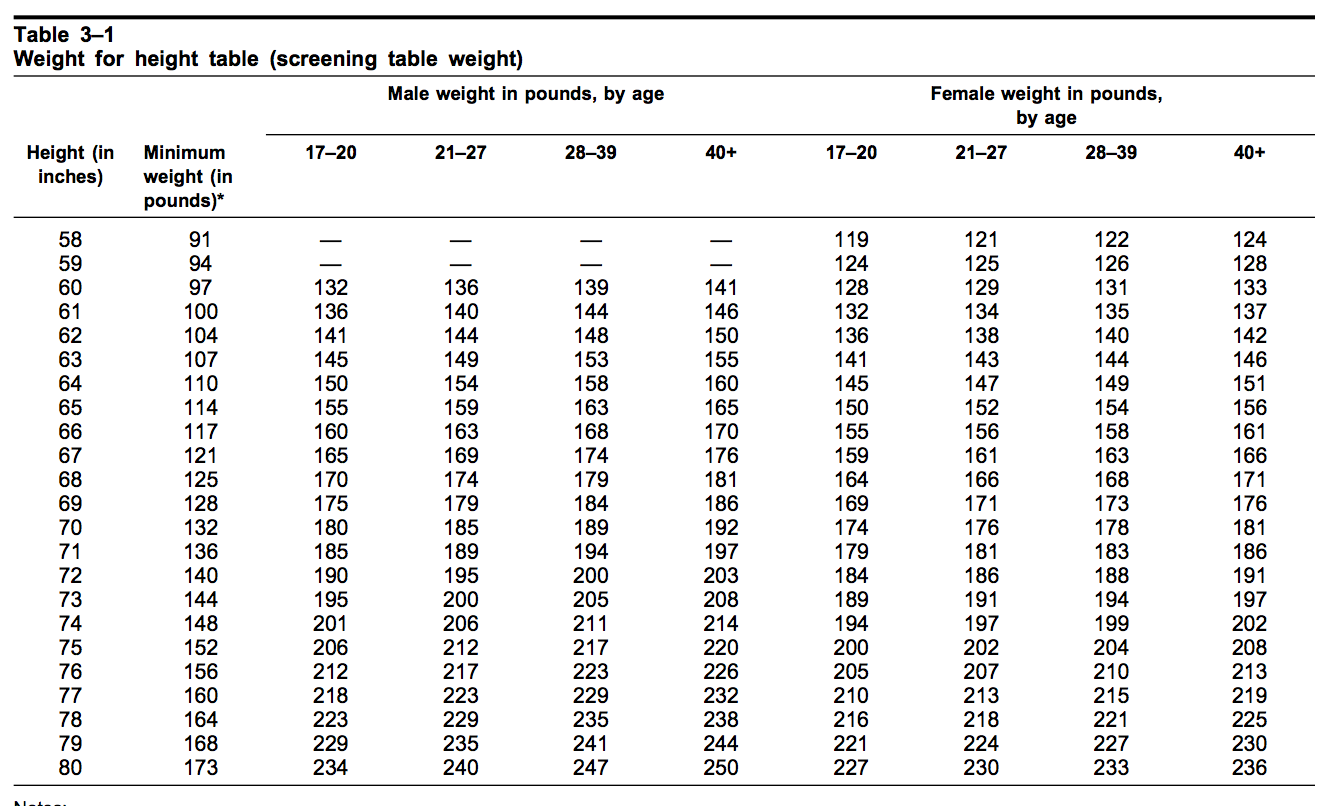In the military, maintaining a certain level of physical fitness is crucial to ensure that soldiers are prepared for the rigors of service. The height and weight standards army guidelines are designed to promote a healthy and fit force that can perform at their best during training and combat. These standards are not merely arbitrary numbers; they reflect the physical demands of military operations and the importance of maintaining optimal health to succeed in various challenging environments.
The Army's height and weight standards have evolved over the years, adapting to changes in society's understanding of fitness and health. With increasing focus on overall wellness, the Army emphasizes a balance between strength, endurance, and agility. This article explores the specific height and weight requirements set forth by the Army, the rationale behind them, and the implications for soldiers seeking to meet these standards.
Understanding these standards is not only important for those who are currently serving but also for potential recruits. Knowledge of what is required can help aspiring soldiers prepare physically and mentally for their journey in the military. As we delve deeper, we will address common questions regarding these standards and provide insights into the testing process, its significance, and how soldiers can effectively meet these requirements.
What are the Height and Weight Standards for the Army?
The Army has established specific height and weight standards that all soldiers must adhere to. These standards vary depending on age and gender, recognizing that body composition can differ significantly across different groups. The regulations are designed to ensure that all soldiers maintain a healthy weight relative to their height, thus promoting overall fitness and readiness.
How is the Height and Weight Measured?
Height and weight are typically measured during the Army's annual fitness assessment. Soldiers are weighed without shoes and dressed in physical training uniforms. Height is measured using a stadiometer, ensuring accuracy. The measurements are then compared to the Army’s established height and weight charts to determine if a soldier meets the required standards.
What Happens if a Soldier Fails to Meet the Standards?
If a soldier does not meet the height and weight standards army guidelines, they may be required to enter a Body Composition Program (BCP). This program aims to help soldiers achieve the necessary body weight and composition through a combination of physical training and nutritional guidance. Failure to comply with the BCP can lead to disciplinary action, including separation from service.
Why are Height and Weight Standards Important in the Army?
The height and weight standards army guidelines serve several critical purposes. Firstly, they ensure that soldiers are physically fit to perform their duties effectively. In military operations, physical fitness can be the difference between life and death. Secondly, maintaining these standards fosters a culture of discipline and accountability, which are key attributes in the military environment.
What are the Health Implications of the Army's Standards?
Meeting the height and weight standards is not just about appearances; it has significant health implications as well. Soldiers who maintain a healthy weight are less likely to experience chronic health issues such as obesity, diabetes, and heart disease. By adhering to these standards, soldiers can enhance their overall well-being, which translates into better performance during training and missions.
How Can Soldiers Meet Height and Weight Standards?
To successfully meet the height and weight standards army guidelines, soldiers can adopt several strategies:
- Regular Exercise: Incorporating a balanced fitness routine that includes cardiovascular, strength, and flexibility training.
- Balanced Diet: Consuming a nutritious diet rich in fruits, vegetables, lean proteins, and whole grains.
- Hydration: Staying hydrated to support overall health and performance.
- Monitoring Progress: Keeping track of weight and body measurements regularly to stay on target.
Are There Exceptions to the Height and Weight Standards?
Yes, there are certain exceptions to the height and weight standards army regulations. For example, soldiers with a high muscle mass may weigh more than the standard but can still be fit and capable. In such cases, body fat percentage measurements may be used instead of weight to assess fitness levels. Additionally, soldiers who are pregnant or on a medical profile may have different requirements.
Conclusion: The Importance of Height and Weight Standards in the Army
In conclusion, the height and weight standards army guidelines play a crucial role in ensuring that soldiers are fit, healthy, and ready to face the demands of military service. By understanding and adhering to these standards, soldiers not only enhance their chances of success within the military but also contribute to the overall effectiveness of the armed forces. Whether you are a current soldier or considering a career in the Army, being aware of these standards can help you prepare for the challenges ahead.
Honoring Memories: Remembering Dad On His Death Anniversary
Unveiling The Depth: The Meaning Behind Polynesian Tattoos
The Intriguing Journey Of Derek Ramsay's Ex-Relationships


